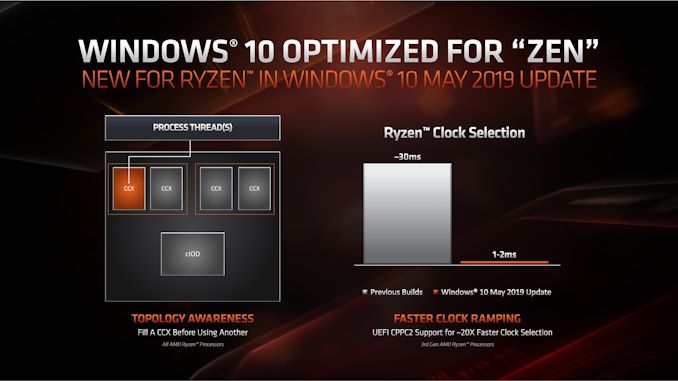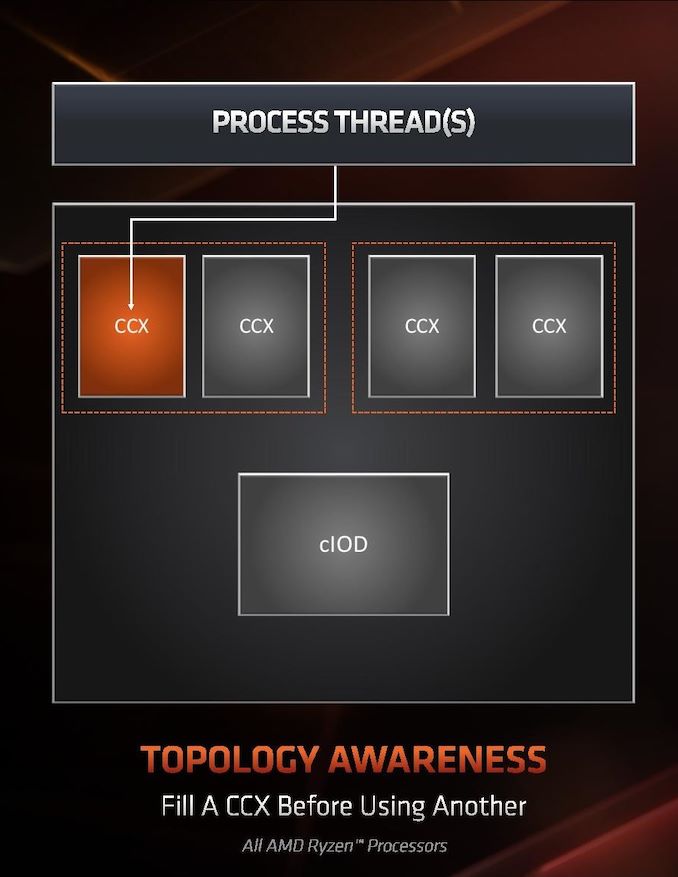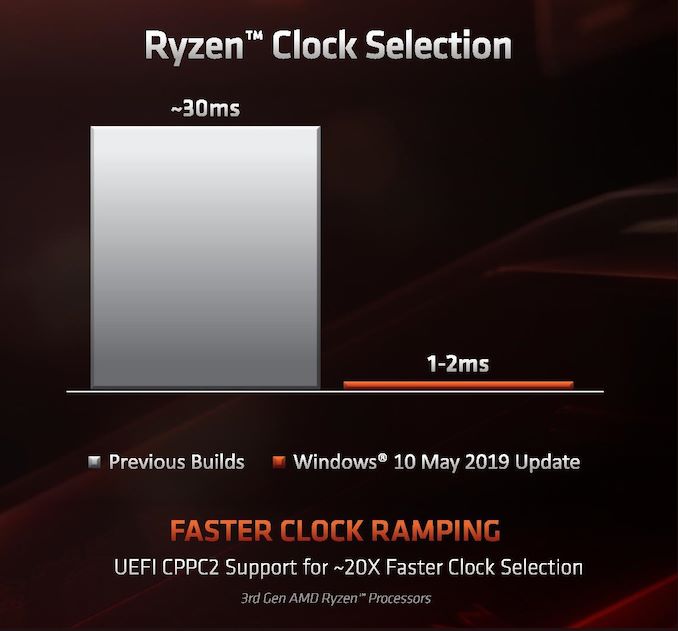AMD Zen 2 Microarchitecture Analysis: Ryzen 3000 and EPYC Rome
by Dr. Ian Cutress on June 10, 2019 7:22 PM EST- Posted in
- CPUs
- AMD
- Ryzen
- EPYC
- Infinity Fabric
- PCIe 4.0
- Zen 2
- Rome
- Ryzen 3000
- Ryzen 3rd Gen
Windows Optimizations
One of the key points that have been a pain in the side of non-Intel processors using Windows has been the optimizations and scheduler arrangements in the operating system. We’ve seen in the past how Windows has not been kind to non-Intel microarchitecture layouts, such as AMD’s previous module design in Bulldozer, the Qualcomm hybrid CPU strategy with Windows on Snapdragon, and more recently with multi-die arrangements on Threadripper that introduce different memory latency domains into consumer computing.
Obviously AMD has a close relationship with Microsoft when it comes down to identifying a non-regular core topology with a processor, and the two companies work towards ensuring that thread and memory assignments, absent of program driven direction, attempt to make the most out of the system. With the May 10th update to Windows, some additional features have been put in place to get the most out of the upcoming Zen 2 microarchitecture and Ryzen 3000 silicon layouts.
The optimizations come on two fronts, both of which are reasonably easy to explain.
Thread Grouping
The first is thread allocation. When a processor has different ‘groups’ of CPU cores, there are different ways in which threads are allocated, all of which have pros and cons. The two extremes for thread allocation come down to thread grouping and thread expansion.
Thread grouping is where as new threads are spawned, they will be allocated onto cores directly next to cores that already have threads. This keeps the threads close together, for thread-to-thread communication, however it can create regions of high power density, especially when there are many cores on the processor but only a couple are active.
Thread expansion is where cores are placed as far away from each other as possible. In AMD’s case, this would mean a second thread spawning on a different chiplet, or a different core complex/CCX, as far away as possible. This allows the CPU to maintain high performance by not having regions of high power density, typically providing the best turbo performance across multiple threads.
The danger of thread expansion is when a program spawns two threads that end up on different sides of the CPU. In Threadripper, this could even mean that the second thread was on a part of the CPU that had a long memory latency, causing an imbalance in the potential performance between the two threads, even though the cores those threads were on would have been at the higher turbo frequency.
Because of how modern software, and in particular video games, are now spawning multiple threads rather than relying on a single thread, and those threads need to talk to each other, AMD is moving from a hybrid thread expansion technique to a thread grouping technique. This means that one CCX will fill up with threads before another CCX is even accessed. AMD believes that despite the potential for high power density within a chiplet, while the other might be inactive, is still worth it for overall performance.
For Matisse, this should afford a nice improvement for limited thread scenarios, and on the face of the technology, gaming. It will be interesting to see how much of an affect this has on the upcoming EPYC Rome CPUs or future Threadripper designs. The single benchmark AMD provided in its explanation was Rocket League at 1080p Low, which reported a +15% frame rate gain.
Clock Ramping
For any of our users familiar with our Skylake microarchitecture deep dive, you may remember that Intel introduced a new feature called Speed Shift that enabled the processor to adjust between different P-states more freely, as well as ramping from idle to load very quickly – from 100 ms to 40ms in the first version in Skylake, then down to 15 ms with Kaby Lake. It did this by handing P-state control back from the OS to the processor, which reacted based on instruction throughput and request. With Zen 2, AMD is now enabling the same feature.
AMD already has sufficiently more granularity in its frequency adjustments over Intel, allowing for 25 MHz differences rather than 100 MHz differences, however enabling a faster ramp-to-load frequency jump is going to help AMD when it comes to very burst-driven workloads, such as WebXPRT (Intel’s favorite for this sort of demonstration). According to AMD, the way that this has been implemented with Zen 2 will require BIOS updates as well as moving to the Windows May 10th update, but it will reduce frequency ramping from ~30 milliseconds on Zen to ~1-2 milliseconds on Zen 2. It should be noted that this is much faster than the numbers Intel tends to provide.
The technical name for AMD’s implementation involves CPPC2, or Collaborative Power Performance Control 2, and AMD’s metrics state that this can increase burst workloads and also application loading. AMD cites a +6% performance gain in application launch times using PCMark10’s app launch sub-test.
Hardened Security for Zen 2
Another aspect to Zen 2 is AMD’s approach to heightened security requirements of modern processors. As has been reported, a good number of the recent array of side channel exploits do not affect AMD processors, primarily because of how AMD manages its TLB buffers that have always required additional security checks before most of this became an issue. Nonetheless, for the issues to which AMD is vulnerable, it has implemented a full hardware-based security platform for them.
The change here comes for the Speculative Store Bypass, known as Spectre v4, which AMD now has additional hardware to work in conjunction with the OS or virtual memory managers such as hypervisors in order to control. AMD doesn’t expect any performance change from these updates. Newer issues such as Foreshadow and Zombieload do not affect AMD processors.














216 Comments
View All Comments
Smell This - Sunday, June 16, 2019 - link
AND ...
it might be 12- to 16 IF links or, another substrate ?
Targon - Thursday, June 13, 2019 - link
Epyc and Ryzen CCX units are TSMC, the true CPU cores. The I/O unit is the only part that comes from Global Foundries, and is probably at TSMC just to satisfy the contracts currently in place.YukaKun - Monday, June 10, 2019 - link
"Users focused on performance will love the new 16-core Ryzen 9 3950X, while the processor seems nice an efficient at 65W, so it will be interesting so see what happens at lower power."Shouldn't that be 105W?
And great read as usual.
Cheers!
jjj - Monday, June 10, 2019 - link
The big problem with this platform is that ST perf per dollar gains are from zero to minimal, depending on SKU.They give us around 20% ST gains (IPC+clocks) but at a cost. Would rather have 10-15% gains for free than to pay for 20%. Pretty much all SKUs need a price drop to become exciting, some about 50$, some a bit less and the 16 cores a lot more.
Got to wonder about memory BW with the 16 cores. 2 channels with 8 cores is one thing but at 16 cores, it might become a limiting factor here and there.
Threska - Tuesday, June 11, 2019 - link
That could be said of any processor. "Yeah, drop the price of whatever it is and we'll love you for it." Improvements cost, just like DVD's costed more than VHS.jjj - Tuesday, June 11, 2019 - link
In the semi business the entire point is to offer significantly more perf per dollar every year. That's what Moore's Law was, 2x the perf at same price every 2 years. Now progress is slower but consumers aren't getting anything anymore.And in pretty much all tech driven areas, products become better every year, even cars. When there is no innovation, it means that the market is dysfunctional. AMD certainly does not innovate here, except on the balance sheet. Innovation means that you get better value and that is missing here. TSMC gives them more perf per dollar, they have additional gains from packaging but those gains do not trickle down to us. At the end of the day even Intel tries to offer 10-15% perf per dollar gains every cycle.
AlyxSharkBite - Tuesday, June 11, 2019 - link
That’s not Moore’s Law at all. It stated that the number of transistors would double. Also it’s been dead a whileSandy bridge 4c 1.16b
Coffee lake 4c is 2.1b (can’t compare the 6c or 8c)
And that’s a lot more than 2 years.
mode_13h - Tuesday, June 11, 2019 - link
Yeah, but those two chips occupy different market segments. So, you should compare Sandybridge i7 vs. Coffelake i7.Teutorix - Tuesday, June 11, 2019 - link
The number of transistors in an IC, not the number of transistors per CPU core. This is an important distinction since a CPU core in Moore's day had very little in it besides registers and an ALU. They didn't integrate FPUs until relatively recently.It's about overall transistor density, nothing more. You absolutely can compare an 8c to a 4c chip, because they are both a single IC.
An 8 core coffee lake chip is 20% smaller than a quad core sandy bridge chip. That's double the CPU cores, double the GPU cores, with probably a massive increase in the transistors/core also.
Moore's law had a minor slowdown with intel stuck at 14nm but its not dead.
Wilco1 - Tuesday, June 11, 2019 - link
Moore's Law is actually accelerating. Just not at Intel. See https://en.wikipedia.org/wiki/Transistor_count - the largest chips now have ~20 Billion transistors, and with 7nm and 5nm it looks like we're getting some more doublings soon.